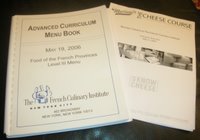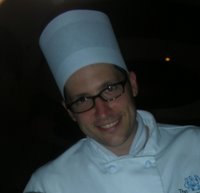LEVEL II WRAPS UP AND LEVEL III BEGINS
 Our first day of Level 3 was in the amphitheater, joined by the Level 4 students (who'd just moved on from Level 3). It's the amphitheater where we had our first class, signed in and were given duffel bags containing uniforms-- the same place where about a month ago I attended the filming of an interview of Thomas Keller by FCI founder, Dorothy Hamilton for a PBS series called, Chef's Story. Tonight we had a lecture and a cheese-tasting.
Our first day of Level 3 was in the amphitheater, joined by the Level 4 students (who'd just moved on from Level 3). It's the amphitheater where we had our first class, signed in and were given duffel bags containing uniforms-- the same place where about a month ago I attended the filming of an interview of Thomas Keller by FCI founder, Dorothy Hamilton for a PBS series called, Chef's Story. Tonight we had a lecture and a cheese-tasting.  First we were given our new recipe book, the recipes for Level III dishes being served on the prix fixe menu in the school's restaurant, L'Ecole. Then we were given our midterm grades. My grade was an 87/100. In two categories, Instructor and Jury, I scored as follows:
First we were given our new recipe book, the recipes for Level III dishes being served on the prix fixe menu in the school's restaurant, L'Ecole. Then we were given our midterm grades. My grade was an 87/100. In two categories, Instructor and Jury, I scored as follows:- Written Examination Bon d'Economat: 20/20
- Chronological Organization & Cleanliness: 17/20
- Preparation & Cooking Methods: 17/20
- Presentation: 17/20
- Degustation: 16/20
To recap, here are the things I came away with:
- Customers should be referred to, thought of, and treated as guests
- Waitstaffs have different methods of serving: pooled tips vs. stations
- Roles: server, runner, busser, hostess, manager, expediter, sous chef, chef, bartender, captain
- Employees should attend pre-meals to know what they're serving
- Employees should know menu descriptions and kitchen descriptions depending on roles
- Dining room appearances: table alignment and numbers, chair placement, silverware placement & serving methods
- Guest perception and table etiquette
- There's a lot of drama that often goes on between the front of the house and the back of the house including fighting, drinking and sex
- The New York restaurant scene is very competitive and a restaurant cannot survive unless the back of the house and the front of the house get beyond the drama and work together
A few things we came away with:
- In the US, unless cheese isn't going to be eaten until 60 days has passed, the milk needs to be pasteurized so that all potentially harmful bacteria are killed
- There are organizations like Old Ways, fighting these restrictions
- Older cheeses have less lactose
- Aging is a process which involves drying out the cheese
- For cheese plates, 3/4 - 1 oz slice of each cheese should be served per plate
- When the cheese-making process is finished, the whey can be used as a fertilizer
- If you eat the rind of some cheeses you'll find that they can have a gritty texture as chewed (as with the Ardrahan). This is because the cheese rind has been washed with a brine water from which the salt has recrystallized.





0 Comments:
Post a Comment
<< Home